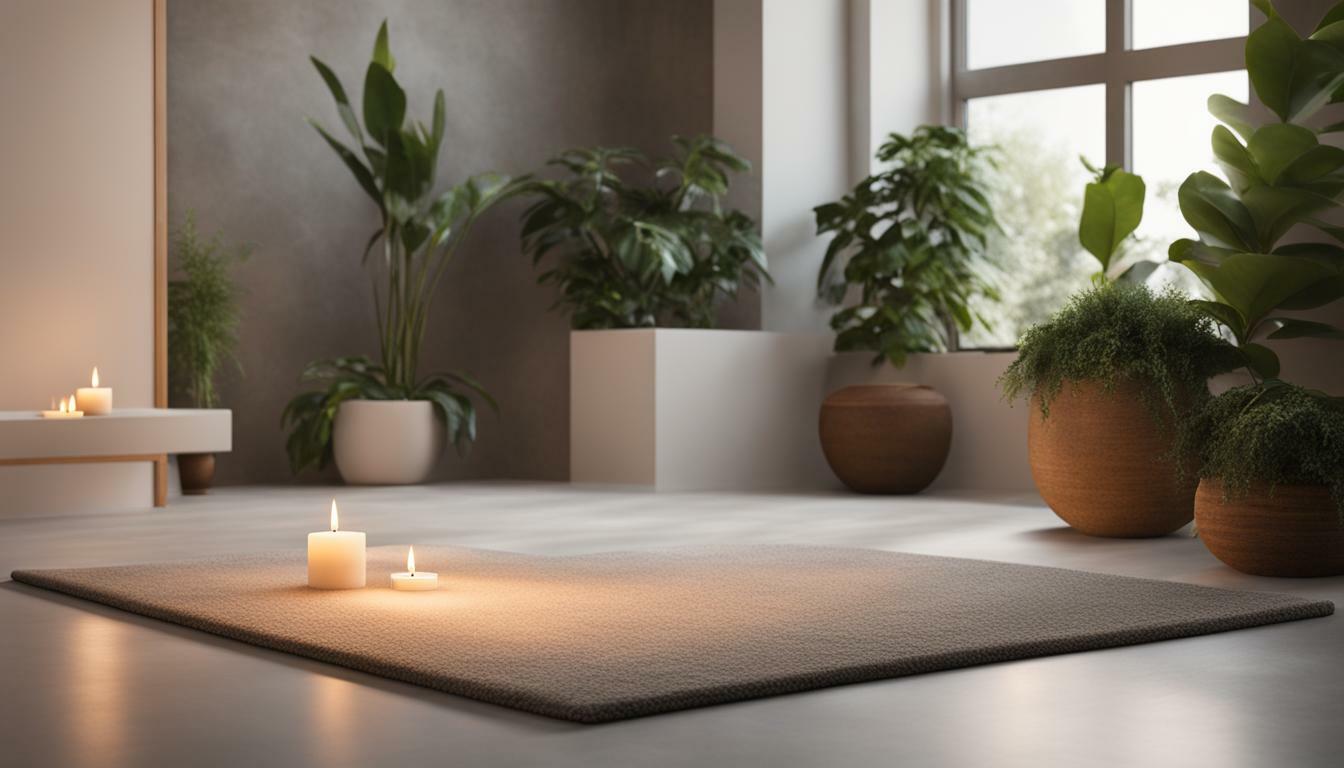Setting up a meditation space in your home can create a serene sanctuary for relaxation and mindfulness. It doesn’t have to be a large or elaborate space; even a small nook or corner dedicated to meditation will suffice. By creating a peaceful meditation space, you can enhance the quality of your practice and bring a sense of tranquility into your daily life.
Key Takeaways:
- Find a quiet spot in your home where you won’t be disturbed.
- Keep the space uncluttered and free from distractions.
- Choose soothing colors and soft lighting for a relaxing atmosphere.
- Incorporate comfortable cushions, blankets, and rugs for a cozy feel.
- Add personal elements such as crystals, mala beads, or photographs to make the space meaningful.
Remember, the most important aspect of a meditation space is that it feels peaceful and conducive to your practice. Now, let’s dive into the details of setting up your own meditation space at home, step-by-step.
Find the Perfect Spot for Your Meditation Space
The first step to setting up a meditation space is finding a quiet spot in your home where you can practice without interruptions. It could be a spare room, a corner in your bedroom, or even a cozy nook in your living room. The key is to choose a location where you feel comfortable and at ease.
Once you have identified the perfect spot, it’s important to keep the space uncluttered and free from distractions. Remove any electronic devices or items that may disrupt your meditation practice. The idea is to create a serene environment that allows you to fully focus on your breathing and mindfulness.
To enhance the ambiance of your meditation space, consider incorporating soothing colors and soft lighting. Earth tones like greens, blues, and neutrals can help create a calming atmosphere. Use natural light whenever possible, but if that’s not an option, opt for soft, diffused lighting that is easy on the eyes.
Now that you have found the perfect spot for your meditation space and set the right ambiance, it’s time to make it comfortable. Add cushions, blankets, and rugs to create a cozy and inviting space. You want to be able to sit or lie down comfortably for extended periods without any discomfort.
| Tips for Setting Up a Meditation Area |
|---|
| Find a quiet spot where you won’t be disturbed. |
| Keep the space uncluttered and free from distractions. |
| Choose soothing colors and soft lighting. |
| Incorporate comfortable cushions, blankets, and rugs. |
Creating a peaceful meditation space
Remember, your meditation space should be a peaceful sanctuary where you can easily slip into a state of relaxation and mindfulness. Experiment with different elements and arrangements until you find what works best for you. Personalize it with objects that hold meaning for you, such as crystals or mala beads. Use soothing scents like aromatherapy oils or candles to enhance the ambiance. Bring a touch of nature into the space with plants. And don’t forget to play soft music or use a noise machine to drown out any background noises that may disturb your practice.
By following these tips and creating a dedicated meditation space in your home, you can cultivate a peaceful environment that supports your practice and enhances your overall well-being. So, go ahead and find that perfect spot in your home to set up your very own meditation sanctuary.
Designing a Relaxing Atmosphere
Designing a relaxing atmosphere is key to cultivating a peaceful meditation space in your home. By creating a space that is visually appealing and soothing, you can enhance the effectiveness of your meditation practice. Here are some tips for designing a calming environment:
- Choose calming colors: Opt for soft, earthy tones like light blues, greens, or neutrals. These colors promote a sense of tranquility and help create a peaceful ambiance.
- Use soft lighting: Avoid harsh, bright lights in your meditation space. Instead, opt for soft, warm lighting options like candles, string lights, or dimmable lamps. Soft lighting can help you relax and ease into a meditative state.
- Create a comfortable seating area: Invest in a comfortable meditation cushion or mat to sit on. Add cozy blankets or rugs to make the space inviting and comfortable. The goal is to create a space where you can fully relax and focus on your practice.
- Add natural elements: Bring in elements of nature to create a sense of serenity. Consider placing a few indoor plants or a small tabletop fountain in your meditation space. These natural elements can help purify the air and create a calming atmosphere.
Remember, the design of your meditation space should reflect your personal taste and preferences. Feel free to incorporate additional elements that resonate with you, such as inspirational quotes displayed on the walls or a small altar with meaningful objects. The goal is to create a space that feels sacred and encourages a deep sense of peace and mindfulness.
| Tip | Benefit |
|---|---|
| Choose calming colors | Promotes relaxation and a peaceful ambiance |
| Use soft lighting | Helps you relax and ease into a meditative state |
| Create a comfortable seating area | Makes the space inviting and comfortable for your practice |
| Add natural elements | Brings a sense of serenity and helps improve air quality |
Adding Personal Elements and Enhancements
Adding personal elements and enhancements can create a serene and Zen-like meditation space that resonates with your individual preferences. By infusing the space with objects of personal meaning, you can create a sacred atmosphere that enhances your practice. Consider incorporating crystals or mala beads, which can serve as visual reminders of your intentions and help you stay focused during meditation.
Aromatherapy oils or candles can also play a significant role in creating an ambiance of tranquility. Choose scents that promote relaxation, such as lavender or sandalwood, and use them sparingly to avoid overwhelming the space. The gentle waft of a calming aroma can bring an added layer of calmness to your meditation experience.
Another way to enhance your meditation space is by including plants. Not only do they add a touch of nature to your surroundings, but they also help improve air quality and create a sense of freshness. Choose low-maintenance plants such as peace lilies or snake plants, and place them strategically around your meditation area.
| Enhancing Your Meditation Space | |
|---|---|
| Crystals and Mala Beads | Visual reminders and focal points for your intentions. |
| Aromatherapy Oils or Candles | Create a soothing ambiance with calming scents. |
| Plants | Add a touch of nature and improve air quality. |
Additionally, consider incorporating soft, ambient music or using a noise machine to drown out any background noises that may disrupt your meditation. The gentle sounds of nature or calming instrumental music can help create a serene environment and promote a deeper sense of relaxation.
Finally, personalizing the space with meaningful objects or photographs can provide a sense of comfort and connection. Whether it’s a cherished family photo, a piece of art that inspires you, or a religious symbol that holds significance, these personal touches can create a space that feels uniquely yours.
Remember, the most important aspect of a meditation space is that it feels peaceful and conducive to your practice. Experiment with different elements and arrangements until you find what resonates with you. By creating a serene and personalized environment, you can enhance your meditation experience and cultivate a deeper sense of mindfulness and relaxation.
Go to https://www.example.com for more information on creating a serene meditation space.
Finding Your Perfect Meditation Space Setup
Finding your perfect meditation space setup involves exploring different elements and arrangements until you discover what brings you tranquility and inner peace. Creating a meditation space in your home can provide a calm and soothing environment for your practice. It doesn’t have to be a large or elaborate space; a small nook or corner dedicated to meditation will suffice. Here are some tips for setting up a meditation space at home:
- Find a quiet spot in your home where you won’t be disturbed.
- Keep the space uncluttered and free from distractions, such as electronic devices.
- Choose soothing colors and soft lighting to create a relaxing atmosphere.
- Incorporate comfortable cushions, blankets, and rugs for a cozy feel.
- Consider adding objects that have personal meaning, such as crystals or mala beads.
- Use aromatherapy oils or candles with relaxing scents to enhance the ambiance.
- Include plants to bring a touch of nature into the space and improve air quality.
- Play soft music or use a noise machine to drown out background noises.
- Personalize the space with meaningful objects or photographs.
- Experiment with different elements and arrangements until you find what works best for you.
Quotes
“Your meditation space should be a sanctuary that reflects your inner peace and tranquility. Take your time to curate a space that resonates with you.”
Remember, the most important aspect of a meditation space is that it feels peaceful and conducive to your practice. Don’t be afraid to get creative and make it your own. It’s your sacred space for inner exploration and serenity.
| Benefits of a Meditation Space: |
|---|
| Enhances relaxation and mindfulness |
| Reduces stress and anxiety |
| Improves focus and concentration |
| Enhances self-awareness and introspection |
| Promotes a sense of inner peace and well-being |
Conclusion
Creating a meditation space in your home can have a profound impact on your practice, providing a tranquil haven where you can find inner peace and rejuvenate your mind and body. It doesn’t have to be a large or elaborate space; even a small nook or corner dedicated to meditation will suffice. By following these tips, you can set up a meditation space that promotes relaxation and mindfulness.
First and foremost, find a quiet spot in your home where you won’t be disturbed. This will allow you to fully immerse yourself in your meditation practice without distractions. Keep the space uncluttered and free from electronic devices, as they can disrupt your focus.
To create a serene atmosphere, choose soothing colors and soft lighting. This will help calm your mind and create a peaceful ambiance. Additionally, incorporate comfortable cushions, blankets, and rugs to make the space cozy and inviting.
Personalize your meditation space by adding objects that have personal meaning to you. Crystals or mala beads can serve as reminders of your intentions, while aromatherapy oils or candles with relaxing scents can enhance the ambiance. Consider including plants to bring a touch of nature into the space and improve air quality. You can also play soft music or use a noise machine to drown out any background noises.
Finally, remember that your meditation space is a reflection of your personal journey. Experiment with different elements and arrangements until you find what works best for you. Whether it’s a dedicated room or a small corner, prioritize creating an environment that feels peaceful and conducive to your practice. With a well-designed meditation space, you can cultivate a deeper sense of peace and tranquility in your daily life.
What Are Some Simple and Effective Meditations I Can Practice in My Home Meditation Space?
Mastering meditation effectively requires finding simple and effective techniques to practice in your home meditation space. Breathing exercises, such as deep belly breathing or diaphragmatic breathing, can help calm the mind and relax the body. Guided visualizations, where you imagine serene scenes or positive outcomes, can enhance focus and clarity. Body scan meditations involve systematically observing sensations throughout the body, promoting relaxation and mindfulness. Experiment with different methods to create a personalized meditation routine that suits your needs.
FAQ
Why is it important to have a designated meditation space at home?
Having a dedicated meditation space creates a calm and soothing environment for your practice. It helps to minimize distractions and allows you to fully immerse yourself in the present moment.
How do I find the perfect spot for my meditation space?
Look for a quiet and undisturbed area in your home where you can relax without interruptions. It could be a small nook, a corner of a room, or even a spare room dedicated solely to meditation.
How can I design a relaxing atmosphere in my meditation space?
Use soothing colors like pastels or earth tones and soft, diffused lighting to create a peaceful ambiance. Incorporate comfortable cushions, blankets, and rugs to make the space cozy and inviting.
What personal elements can I add to my meditation space?
Consider incorporating objects that have personal meaning to you, such as crystals, mala beads, or inspirational quotes. You can also use aromatherapy oils or candles with relaxing scents to enhance the atmosphere.
How can I find the perfect setup for my meditation space?
Experiment with different elements and arrangements until you find what works best for you. Everyone’s preferences are unique, so trust your intuition and create a space that resonates with your personal style and needs.








